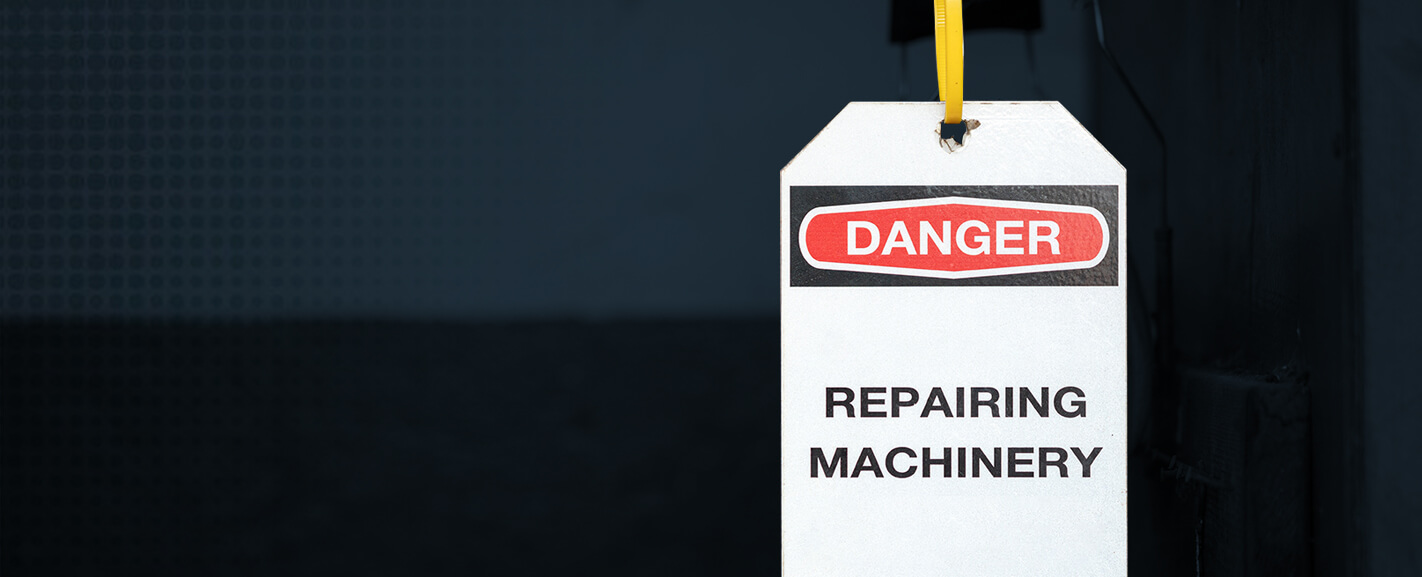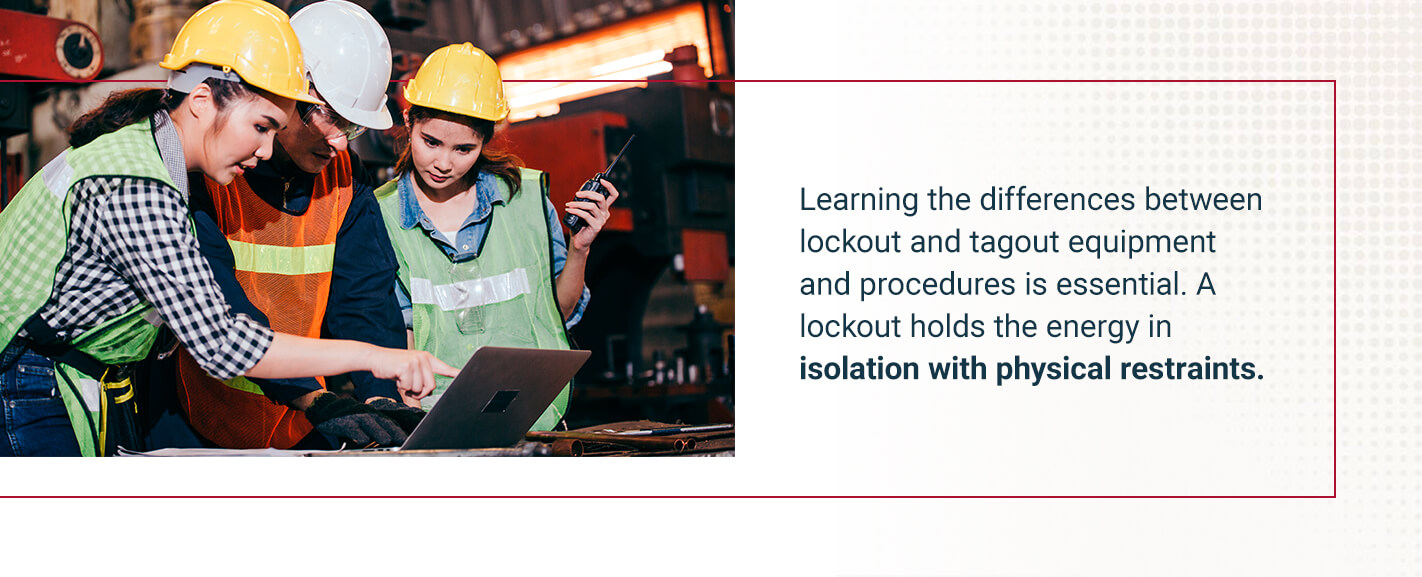OSHA Lockout Tagout Standards

OSHA’s lockout tagout standards regulate equipment service and maintenance. Closely following these rules and procedures is pivotal to preventing an unsafe workplace. Learning the differences between lockout and tagout and which standards apply to your industry can help you make your business safer and properly train employees.
What Is Hazardous Energy, and How Does It Affect the Workplace?
Hazardous energy sources may include hydraulic, chemical, thermal, pneumatic, electrical, and mechanical equipment. When employees service and maintain this equipment, it can often result in dangerous situations if the machines start unexpectedly or suddenly release stored energy. In many cases, releasing hazardous energy could result in severe injury or death. Many workers who repair or maintain energy equipment have suffered harm due to improper standards and a lack of machine control.
Some hazardous energy injuries may include the following.
- Electrocution: Electrical machines could produce a current and shock employees standing nearby or handling equipment.
- Burns: Some machinery might severely burn a worker’s body.
- Crushing: Sudden energy releases could result in crushing when maintaining or servicing equipment.
- Cutting: Any equipment or machines with moving parts may cause cuts and bruises.
- Lacerations: Moving parts might cause deep lacerations to nearby workers.
- Amputation: Some employees could lose a hand, foot, or limb if the machine suddenly starts.
- Fractured body parts: Those who maintain or repair equipment might experience a broken body part from suddenly moving machinery.
Examples of sudden energy release may look like a steam valve automatically turning on and burning an employee or internal wiring shorting out and shocking a repair person. Whatever the case, injuries from sudden energy release are preventable with the proper lockout and tagout procedures. Whether you are an electrician, laborer, or machine operator, following rules and regulations at every step is essential.
What Is LOTO, and How Can You Train Your Employees?
Lockout and tagout — often abbreviated to LOTO — refers to the OSHA standards for controlling hazardous energy. It aims to protect employees from potentially dangerous energy releases and unexpected equipment startups. OSHA provides steps for disabling such equipment and keeping it locked and safe until a qualified person can maintain or repair it.
Learning the differences between lockout and tagout equipment and procedures is essential. A lockout holds the energy in isolation with physical restraints. It’s impossible to remove these restraints except with a special key.
Tagout devices warn employees who might not know the equipment is under maintenance. They prevent staff members from accidentally reenergizing devices and potentially putting other employees at risk. While tagout might not offer the same protection as lockout, it can be helpful in specific industries.
Many LOTO kits use a combination of tags, padlocks, and devices to help manage procedures from a central place. Thoroughly training your employees in lockout and tagout procedures is essential to ensure they isolate hazardous energy by de-energizing and locking out machines.
Failing to follow these practices can result in citations, fines, injuries, or fatalities. Ignoring compliance might lead to employee injuries that reduce productivity. According to OSHA, your industry must follow energy control guidelines and lockout devices, provide mandated training for employees in various positions and duties, and regularly inspect LOTO devices.
What Is the OSHA Standard for Lockout Tagout?
Many businesses wonder which OSHA standard covers lockout and tagout regulations. If your industry uses machinery under LOTO requirements, you must follow the rules under the Control of Hazardous Energy Title 29 CFR Part 1910.147 and 1910.333.
Under the standard, applicable industries must disable machinery during repair and maintenance work. The LOTO procedures aim to protect employees from hazardous energy, equipment, and electrical circuits. Industries with potentially dangerous machinery must use a lockout program — or tagout program of equal protection — whenever the machine is under service or maintenance.
Lockout and tagout procedures take the equipment offline and remove its ability to energize by locking it in an off position. Only the person who placed the lock can remove it once they finish repair and maintenance.
Other fundamental requirements under the OSHA standard include the following.
- Energy control programs: Employers must produce, implement, and enforce programs and procedures for energy control.
- Lockout devices: Companies must use lockout devices at every point in repair and maintenance procedures. Alternatively, workers can use tagout devices if they provide equal protection.
- Authorized devices: All lockout and tagout devices must be authorized and protective.
- New equipment lockouts: New or refurbished equipment must have lockout abilities.
- Proper training: Industries must adequately train employees on lockout and tagout.
- User identification: All LOTO devices must use correct user identification for unlocking procedures.
- Yearly training: Companies must provide annual training for employees.
- Inspections: Companies must inspect their lockout and tagout devices and policies.
Who Must Follow OSHA LOTO Standards?
OSHA LOTO standards related to hazardous energy control and lockout and tagout procedures apply to industries using, servicing, and maintaining specific machinery. According to OSHA, their LOTO standards apply if you have employees who service or maintain machines that could unexpectedly release stored energy, suddenly start, or produce energization. Any of these instances could cause injury or result in fatality.
The standards also apply to any machines or equipment that produce energy in general, including but not limited to thermal, mechanical, chemical, electrical, hydraulic, and pneumatic equipment.
OSHA LOTO standards do not apply to hazards associated with premise wiring installation or conducting equipment. Consider 29 CFR Part 1910 Subpart S if you need more clarification. The standards do not apply to the construction, agriculture, maritime, or oil and gas industries, as these sectors have separate standards for hazardous energy control.
Train Employees in OSHA Standards With Help From NASP
The National Association of Safety Professionals offers reliable workplace safety training for various industries. Whether you work in the construction, government, oil and gas, or general industry, our unique training style can fit your specific business needs. Consider using our classroom, online, or site-specific training or completing our professional certificate courses. We offer environmental and safety consultation services for companies that want to ensure workplace adherence to regulations.
Our innovative methods provide interactive training for your industry-specific requirements. Qualify yourself to provide in-house training on lockout and tagout procedures by joining us in Raleigh, N.C., on May 16 and 17 for our Lockout Tagout Train-the-Trainer course. If you don’t have time to get away from the office, you can take our Lockout Tagout Specialist course anytime online.
Contact us today to speak to a representative, or call us at 800-922-2219.
Blog Posts
Latest Posts
Related Posts






